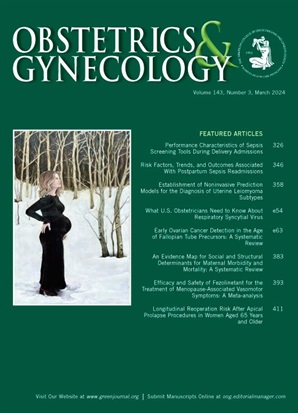Comparative Age-Stratified Analysis of Live-Birth Outcomes in Primary Embryo Transfer to Assess the Effect of Preimplantation Genetic Testing for Aneuploidy.
IF 4.7
2区 医学
Q1 OBSTETRICS & GYNECOLOGY
引用次数: 0
Abstract
OBJECTIVE To investigate whether the perceived advantages of preimplantation genetic testing for aneuploidy (PGT-A) are attributable to genetic testing itself or to transferring a thawed frozen embryo into a receptive endometrium. We compared live-birth and cumulative live-birth outcomes across three groups: primary frozen embryo transfer (FET) with PGT-A, FET without PGT-A, and fresh transfers in initial autologous assisted reproductive technology (ART) cycles. METHODS We performed a retrospective analysis from the 2014-2020 Society for Assisted Reproductive Technology Clinic Outcome Reporting System database, comparing success rates of primary FET with PGT-A, FET without PGT-A, and fresh transfers. Live birth, cumulative live birth, and miscarriage rates were compared, with primary transfer defined as the first transfer after the index retrieval. Live-birth rate was defined as the likelihood of live birth from the first transfer; cumulative live-birth rate was the likelihood of a live birth from all transfers within 1 year of the initial retrieval. Multivariate logistic regression determined the association of live birth with FET with PGT-A, FET without PGT-A, and fresh transfers while controlling for various demographic and clinical factors. RESULTS We examined 263,521 first autologous ART cycles between 2014 and 2020 that resulted in primary embryo transfer. The live-birth rate was 56.0% for FET with PGT-A, 48.3% for FET without PGT-A, and 39.8% for fresh transfers (P<.001). Cumulative live-birth rates were similar between the two frozen strategies (74.1% with PGT-A vs 74.0% without PGT-A, P=.66); both were higher than fresh transfers (60.0%, P<.001). In patients younger than age 38 years, cumulative live-birth rates were higher for FETs without PGT-A (P<.01). In those 38 years and older, PGT-A was associated with higher cumulative success (P<.001). Regression analysis demonstrated that FET, regardless of PGT-A use, was associated with higher odds of live birth across all age groups, whereas PGT-A conferred additional benefit only in patients aged 35 years or older, with increasing advantage with advancing age. CONCLUSION Primary FETs were associated with better outcomes than fresh transfers. Although PGT-A use improved outcomes for older patients, no overall benefit was seen in younger patients. These findings bring into question the perceived advantage of PGT-A over FETs without PGT-A, particularly in those younger than age 38 years, in whom FET without PGT-A demonstrated a higher cumulative live-birth rate compared with cycles with PGT-A. These data highlight the need for cautious consideration of PGT-A utilization for initial transfer, especially in younger age groups.原发胚胎移植中活产结果的年龄分层比较分析,以评估植入前基因检测对非整倍体的影响。
目的探讨非整倍体植入前基因检测(PGT-A)的优势是否归因于基因检测本身或将解冻的冷冻胚胎移植到接受性子宫内膜。我们比较了三组的活产和累积活产结果:首次冷冻胚胎移植(FET)加PGT-A, FET不加PGT-A,以及在初始自体辅助生殖技术(ART)周期中新鲜移植。方法回顾性分析2014-2020年美国辅助生殖技术学会临床结果报告系统数据库,比较首次FET加PGT-A、不加PGT-A和新鲜移植的成功率。活产率、累计活产率和流产率进行比较,首次转移定义为索引检索后的第一次转移。活产率定义为第一次移植后活产的可能性;累积活产率是指在首次检索后1年内所有转移的活产的可能性。在控制各种人口统计学和临床因素的同时,多因素logistic回归确定了活产与FET合并PGT-A、FET不含PGT-A和新鲜转移之间的关系。结果:2014年至2020年间,我们检查了263521例首次自体ART周期导致的原代胚胎移植。有PGT-A的FET的活产率为56.0%,无PGT-A的FET为48.3%,新鲜移植的FET为39.8% (P< 0.001)。两种冷冻策略的累计活产率相似(使用PGT-A组74.1% vs不使用PGT-A组74.0%,P= 0.66);两者均高于新鲜转移(60.0%,P< 0.001)。在年龄小于38岁的患者中,没有PGT-A的fet患者的累计活产率更高(P< 0.01)。在38岁及以上的患者中,PGT-A与较高的累积成功率相关(P< 0.001)。回归分析表明,无论是否使用PGT-A, FET在所有年龄组中都与较高的活产率相关,而PGT-A仅在35岁及以上的患者中具有额外的益处,并且随着年龄的增长而增加。结论首次fet治疗的预后优于新鲜fet治疗。尽管使用PGT-A改善了老年患者的预后,但在年轻患者中没有发现总体获益。这些发现对PGT-A优于不加PGT-A的FET的感知优势提出了质疑,特别是在年龄小于38岁的人群中,不加PGT-A的FET与加PGT-A的周期相比显示出更高的累积活产率。这些数据强调需要谨慎考虑PGT-A在初始转移中的应用,特别是在较年轻的年龄组。
本文章由计算机程序翻译,如有差异,请以英文原文为准。
求助全文
约1分钟内获得全文
求助全文
来源期刊

Obstetrics and gynecology
医学-妇产科学
CiteScore
11.10
自引率
4.20%
发文量
867
审稿时长
1 months
期刊介绍:
"Obstetrics & Gynecology," affectionately known as "The Green Journal," is the official publication of the American College of Obstetricians and Gynecologists (ACOG). Since its inception in 1953, the journal has been dedicated to advancing the clinical practice of obstetrics and gynecology, as well as related fields. The journal's mission is to promote excellence in these areas by publishing a diverse range of articles that cover translational and clinical topics.
"Obstetrics & Gynecology" provides a platform for the dissemination of evidence-based research, clinical guidelines, and expert opinions that are essential for the continuous improvement of women's health care. The journal's content is designed to inform and educate obstetricians, gynecologists, and other healthcare professionals, ensuring that they stay abreast of the latest developments and best practices in their field.
 求助内容:
求助内容: 应助结果提醒方式:
应助结果提醒方式:


